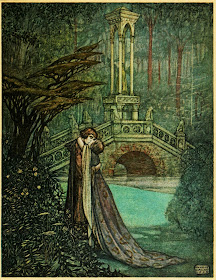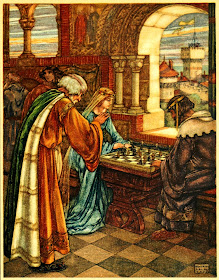I did find a capsule review of the The Romance of Tristram and Iseult, published October 8th, 1910, in the New York Times, under the heading, Philadelphia Book News, with the following text:
PHILADELPHIA, Oct. 7. -- Next Monday has been fixed for the issue by the J. B. Lippincott Co. of a sumptuous edition of "The Romance of Tristram and Iseult," translated from the French of Joseph Bedier by Florence Simmonds. This promises to be one of the most beautiful of the gift books of the season, the distinguishing characteristic of this edition being the thirty-two remarkable colored illustrations by Maurice Lalau.
The scary part is that the review states there are 32 illustrations, and the edition found at archive dot org, only has 20 remarkable color illustrations. If there are an additional 12, I dearly want to see them.
Click the link to view these amazing illustrations in their original context at archive dot org. The Romance of Tristram and Iseult was published by William Heinemann out of London, and by J. B. Lippincott out of Philadelphia, in 1910. William Heinemann is the same publisher who published much of Arthur Rackham's best known work.
It is a wonder more attention has not been paid to this illustrator. When I view the larger body of Lalau's available art and illustrations, I see parallels to the line work and drama of Arthur Rackham, including his droll sense of humor; and the composition and colors of Edmund Dulac. I strongly suspect and propose Maurice Lalau's influence, or perhaps he was influenced by them; and if I were ever to earn an advanced degree in art history, I would explore this potential connection.
If anyone has knowledge of Maurice Lalau, please share your information in comments, and add any links. Here are a few bits of information I've come across, here, here, and here, and here.
What I love about these illustrations is the rich color, and fully realized world, the room interiors and building exteriors executed in loving detail, including trunks and tapestries, musical instruments, books, looms, clothing, games, utensils, and a child's toys; and the drama of every scene, where every figure is a personality, major or minor, with an integral role; and the balance of indoor and outdoor presentations, and the depictions of sunset, daytime and moonlight. I can only imagine the artist immersed himself in historical description and visual references, and made numerous preliminary sketches.
I copied these illustrations at the highest possible resolution, and worked with the brightness and contrast to lighten them just a touch to bring out the detail, while retaining the original color tones and balance. The original scans are exceptionally good.
Click on each image for great detail.
 |
| Maurice Lalau ~ The Romance of Tristram and Iseult ~ 1908 Translated from the French by Florence Simmonds London: William Heinemann, c1910 Frontispiece: Tristram and Iseult |
 |
| Maurice Lalau ~ The Romance of Tristram and Iseult ~ 1909 Translated from the French by Florence Simmonds London: William Heinemann, c1910 Tristram spurred his horse against him with such fury... |
 |
| Maurice Lalau ~ The Romance of Tristram and Iseult ~ 1909 Translated from the French by Florence Simmonds London: William Heinemann, c1910 The lovers lived crouching in the hollow of a rock... |
 |
| Maurice Lalau ~ The Romance of Tristram and Iseult ~ 1909 Translated from the French by Florence Simmonds London: William Heinemann, c1910 She stretched out her arms on either side, the palms open. |
 |
| Maurice Lalau ~ The Romance of Tristram and Iseult ~ 1909 Translated from the French by Florence Simmonds London: William Heinemann, c1910 Under the trees he pressed her to his heart without a word. |
 |
| Maurice Lalau ~ The Romance of Tristram and Iseult ~ 1909 Translated from the French by Florence Simmonds London: William Heinemann, c1910 The Queen sings sweetly. |
 |
| Maurice Lalau ~ The Romance of Tristram and Iseult ~ 1909 Translated from the French by Florence Simmonds London: William Heinemann, c1910 King Mark and Iseult the Fair were seated at chess. |
 |
| Maurice Lalau ~ The Romance of Tristram and Iseult ~ 1908 Translated from the French by Florence Simmonds London: William Heinemann, c1910 Tristram disguised himself as a beggar. |
 |
| Maurice Lalau ~ The Romance of Tristram and Iseult ~ 1909 Translated from the French by Florence Simmonds London: William Heinemann, c1910 She gave up the ghost and died beside him for grief. |
 |
| Maurice Lalau ~ The Romance of Tristram and Iseult ~ 1910 Translated from the French by Florence Simmonds London: William Heinemann, c1910 Title Page |












Isn't this artist marvelous? I 'discovered' this book a couple of years ago and have been on the lookout for more like it since. There are a couple more books with his illustrations on the archive site, but not to equal these.
ReplyDeleteThe Golden Age still has treasures yet to be dug up!
Hi Thom,
ReplyDeleteIt felt like a discovery. I've bookmarked a few more of his books at archive dot org, and I'll feature a few favorites at some point; but this book is the pinnacle for me. If you follow the first link to additional information, you will find his work in later years to be completely different, and much admired for style and technique; that article also includes a bit of biographical detail.
I keep perusing the "archive" and find treasures, big and small, all over- but this find was incredible, since his work is barely featured online anywhere- until now! And the archive scans for these illustrations were so well done, it feels like finding "gold."
Hi
ReplyDeleteNice to see one of the beauties of archive.org featured here! The other titles I found there are Contes Mauve and Grandmother's Fairytales. If you've found other titles I would love to hear about these!
One remark though: be careful with the color enhancement, the prints tend to get a little bit the "Dover-look" (sorry Jeff Menges)
greetings
Saahabi
Hi Saahabi,
ReplyDeleteThank you for your comments! I found a couple of Lalau's works through Archive dot org, and I'm keeping my "fingers crossed" on a couple of titles I'm hoping to get through Interlibrary Loan, so I can carefully scan the images.
Re: the Dover look, I know exactly what you mean, and I try to avoid it! I enjoy the fact Dover has put together so many great collections, but the color quality and resolution is lacking. That's why with this set of scans for Lalau's work, I made sure not to change the color balance. I did lighten them, so the detail would show better on a computer screen. These are among the best scans I've ever seen on archive dot org, so I'm glad you "clicked in" to see the originals.
Wow--These are incredible. The depth of color is toothsome--something I'm not used to seeing(alas, nearly all the classic illustrators works I've seen are from poorly reproduced scans). Archive.org is definitely something I need to explore. Thanks for putting these posts and info out there.
ReplyDeleteHi Tom, Thank you! Since I published this set of illustrations based on the archive dot org scans, I now own a copy of this beautiful book. The illustrations are actually only 6" by 4 5/8". The color is very close to what I was able to reproduce on a computer screen. The depth of composition and color on such a small scale is truly incredible. I'd love to see the original paintings!
DeleteI especially love, 'Under the trees, he pressed her to his heart'.
ReplyDeleteIt's beautiful, isn't it? It captures love and the night in a magical setting.
DeleteHi, I just found your page from Stephen Ellcock's link on Facebook, I hadn't seen this artist before, wonderful images, thank you for sharing them!
ReplyDelete